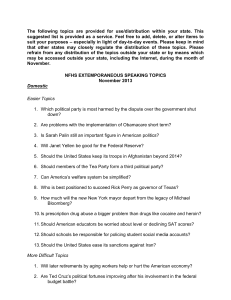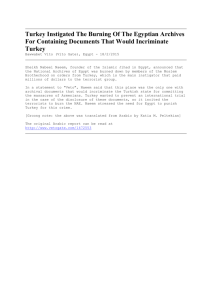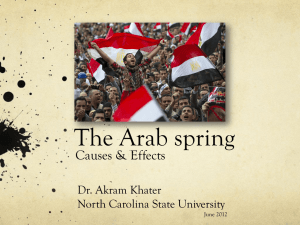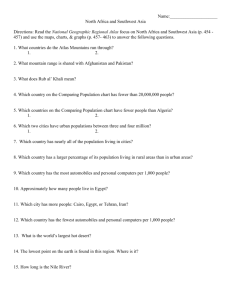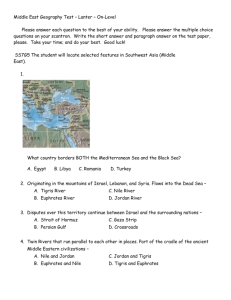9. State Consolidati..
advertisement
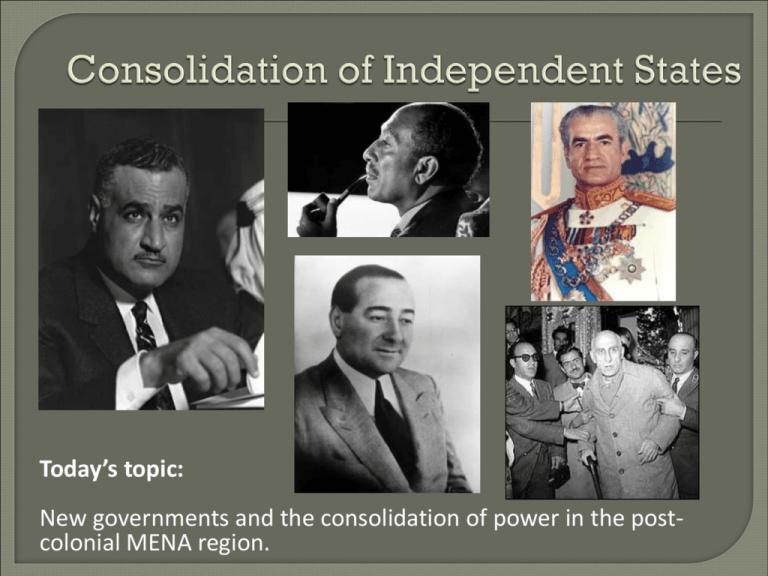
Today’s topic: New governments and the consolidation of power in the postcolonial MENA region. Exam on Monday the 21st • Will post all power points to date after class • Will post a review sheet (draft) after class READING QUIZ • Adnan Menderes • White Revolution • United Arab Republic • Nasserism MOVING FORWARD… Jews in Europe before emancipation • Haskalah movement toward integration, secularization, “come out of ghetto” • Continued pogroms and Jewish political movements (Zionism, Folkism, Territorialism) • Nationalist Ideology of Zionism Important works & figures establishing the Zionist Movement Hebrew over Yiddish – culture at work Imagining Palestine as Empty Land Jabotinsky’s Revisionist Zionism (“Historical Israel”) British Mandate Conflicting White Papers Balfour Declaration 1922 White Paper under Sir Herbert Samuelson • Division of Opposition (Husayni-Nashashibi Rivalry) • Peel Commission and 1939 McDonald White Paper (Partition) Yishuv • Histadrut • Haganah • David Ben Gurion (kibbutznik) • Immigration and settlement efforts Jewish State • Jewish insurgency (Haganah, Irgun, Lehi) against British Mandate • British give up Mandate to UN that formed Palestine Commission (UNSCOP) that decided to partition the land between Jewish & Arab states Zionist reluctant acceptance Arab rejection and their reasoning • British withdraw, Ben Gurion declares state • Arab-Israeli War 1948 and the parties involved Post World War II State Consolidation How do states consolidate power? Cases of Turkey, Egypt, Iran Cold War Lens: • WWII brought about change in international environment • Support by both US and Soviets (financial & weaponry) • General Characteristics of the cold war in developing states: • military bases • keep imperial territories after independence (patronage) (Great Britain in Iraq, Jordan, Egypt; France in Lebanon) • Anti-nationalist fights (France against Algerian FLN) • Regional security alliances (Baghdad Pact, 1954) Different regime types just after independence: • Self-imposed monarchs (Afghanistan, Saudi Arabia) • Monarchs imposed or supported by colonial powers (Muhammad Reza, King Faruq, Libyan Sanusis (King Idris), King Abdullah, King Feisel • Governments based on nationalist liberation movements (FLN – Algeria, Destour - Tunisia) • Democracies (Lebanon, Israel, Turkey) Changes after independence: • Some liberalization (Jordan, Morocco) • Military coups (Libya, Syria, Egypt, Iraq…) • Revolution (Iran) • Civil war (Yemen, Lebanon, Taliban) • Foreign invasion & war (Afghanistan, Arab-Israeli Conflict, Iraq and Afghanistan today) • Elections (Turkey, Mossadegh episode) How do governments consolidate power? Distributing rents (oil income, Suez canal, or wooing foreign aid) as Patronage Ideology (Islamization, Zionism, Arabism, Ba’athism) Riding popular waves (Egyptian Islamization, Jordanian Nasserism, Saddam’s use of Islamic symbols in 90s) Encouraging rival dissent groups under guise of pluralism (Sadat’s blunder, Hamas) Social reengineering (Iraq) Suppression (Savak in Iran) or seeming benign Weakening potentially political structures like but still threat (Morocco, Jordan) tribes and clans Outright brutality (Hama Massacre ’82, Black Leveraging minorities (2-step leverage): Jews September) in Morocco, Shah’s Bahais, Circassians in Jordan, all non-Sunnis in Syria, Sunni regional minorities Saturation & Cult of Personality (Asad) in Iraq Elections to diffuse dissent (Jordan) Create balanced and redundant security and Partial concessions to opposition military forces (Syria) Use of foreign powers (Saudis, Bahrain) Use of foreign threats as pretext for action Controlling the economy Use of sophisticated strategies: Divide & rule (Jordan), cooption (M.R. Shah and attempted w/ Mossadeq), Hearts and Minds State employment (Egypt, Syria) Institutional changes (courts, election procedures, etc.) When are governments overthrown? When they fail to do these things well. The strategy consists of: Differentiating among active fighters, passive supporters, genuine neutrals, and government loyalists. This, of course, requires a centralization of the flow of information to know who’s who. Geographically, physically or psychologically isolating those identified as the active rivals of the state from others. This requires a highly coordinated and thus centralized military effort. Providing positive sanctions to potential supporters of rival organizations and protecting them from abuse by undisciplined troops to discourage them from supporting rivals. Cooption is a strategy initiated by a dominant organization or coalition of organizations that consists of offering positive sanctions to other threatening organizations or key individuals within them in return for accepting the norms of interaction desired by the dominant organization or coalition Saturation (Hafez al-Asad) Why did some monarchies last while others were overthrown? • The influence of the royal family (Michael Herb’s “All in the Family” theory) • Rentier state • Oppression & dissatisfaction • Strategic skills of ruler • Strategic skills of coup leaders • External forces (relationships w/ major powers) Divergent roles played by armies: • Army as arbiter & veto player (Turkey, Algeria) • Army as providing leadership (Egypt) • Army as pillar of support (Jordan) • Army as potential rival to ruler (Syria) Turkey Turkey • Democrats win election in 1950 • Did not like intrusiveness of Kemalist RPP • Smaller changes, not major reversal of Kemalism (education, private property, scale back secularism, etc) • Growing national debt and repression • Reactionary protests • 1960 Coup d’etat through military junta • New Constitution and 2nd Republic (1961-1980) • Turmoil, urbanization, demographic change • Proxy conflicts (Cold War influence) in 1970s •Military let fester then intervened in 1980 with ‘Coup by Memorandum’ • Restoration of Democracy in 1983 w/ election of Motherland Party Iran and its oil fields Iran • Muhammad Reza Shah • Domestic coalition tribal leaders, ulama, landowning elite • Domestic opposition labor movement & middle class • Foreign Powers • UK – support of MRS, tribal leaders, landowning class • Control of oil through Anglo-Iranian Oil Company (AIOC) • Soviets – support of Tudeh Party • US – supported Iranian army for stability and opposition to Soviet ambitions (containment) • Widespread sentiment against foreign interference • Mohammed Mossadeq and National Front Coalition • Key Issue: Nationalizing the AIOC • Passed nationalization law in Majlis and elected Mossadeq to position of Prime Minister (1951-53) • US and UK boycott Iranian oil after nationalization • Boycott hurts Mossadeq’s ability to implement democratic reforms • Fissure in Mossadeq’s National Front Iran (cont.) • US (CIA) and UK (MI6) assist in overthrowing Mossadeq in coup to reinstate Muhammad Reza Shah • First failed, then succeeded • Return of royal dictatorship and authoritarian rule (even more oppressive) • Agreement b/w UK and Iran for 50/50 revenue split of oil revenues • Military aid for MRS to consolidate power • period of harsh authoritarianism • opposition led by Ayatollah Khomeini • White Revolution (bloodless, top down) starting in 1963 • Major social, economic, political reforms • private ownership of land, increase in education, social welfare, women’s enfranchisement, etc. • Maintained corrupt regime • uneven distribution of income and continued political repression • Growing opposition (especially by religious establishment) Egypt, Sinai, Strait of Tiran EGYPT • Corruption of Faruq and Wafd •Displeasure after embarrassing 1948 War • Wafd Split • Free Officers Coup (1952), RCC, in-fighting, MB opposition • Nasserism (from Pan-Arab nationalism to Arab Socialism) • Transition Period and Consolidation • Cold War Lens • Complex Relationship with British • Baghdad Pact • Search for Arms • Aswan High Dam issue • Nationalization of Suez • 1956 Suez War • United Arab Republic
